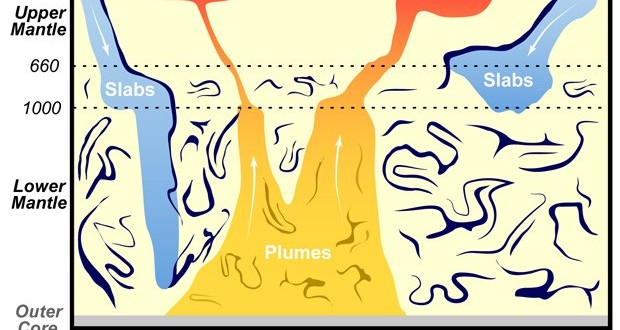Evidence for both mixing and layering of Earth’s interior clarifies debate
 Some slabs sink deep into the mantle, others stall at approximately 1,000 km depth. This behavior can be explained by moderate mantle layering with an accumulation of basalt (blue squiggles) in the lower mantle. Basalt was originally been subducted into the mantle as oceanic crust, and is recycled by plumes that feed volcanoes beneath a hotspot. (credit: M. Ballmer)
Some slabs sink deep into the mantle, others stall at approximately 1,000 km depth. This behavior can be explained by moderate mantle layering with an accumulation of basalt (blue squiggles) in the lower mantle. Basalt was originally been subducted into the mantle as oceanic crust, and is recycled by plumes that feed volcanoes beneath a hotspot. (credit: M. Ballmer)Earth’s mantle, the large zone of slow-flowing rock that lies between the crust and the planet’s core, powers every earthquake and volcanic eruption on the planet’s surface. There has been a long-standing debate in the geosciences on whether the lower and upper mantles are different in composition or well mixed. A study published in Science Advances by lead author Maxim Ballmer, senior scientist at ETH Zurich and former postdoctoral fellow SOEST, suggests that mixing due to mantle flow indeed occurs on a global scale, but discrete layers where material with similar composition has aggregated are nevertheless maintained.
Whereas the composition of Earth’s upper mantle can be estimated from lava outpourings on the ocean floor at mid-ocean ridges, the lower mantle remains poorly understood. Chemical observations indicate that the composition of the lower mantle may be different from the composition of the upper mantle. On the contrary, seismic tomography—creating images of Earth’s interior using earthquake-generated waves—provides evidence that the whole mantle is stirred, and presumably well-mixed.
Read more about it in the UH System News.



